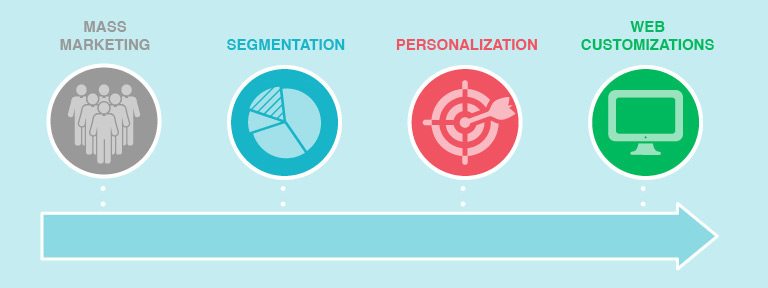Websites are the modern day calling card, storefront and customer service department of today’s businesses. People are now more comfortable browsing and purchasing on the web, and our mobile phones are the first place we go to search for information, entertainment and products; a one-size-fits-all approach is no longer an adequate way to provide relevance and bolster affinity between multiple audiences and your brand.
Through the use of tagging, tracking and content categorization tactics, creating a custom content experience is easier than ever. Customer relationship management systems (CRMs) allow us to catalog individual audience characteristics and make it easy to practice segmentation. While this is a great start, as an industry we should aim for more one-on-one connections through the use of personalization and custom web experiences.

Segmentation is the act of identifying groups of users with a similar, high-level commonality. Examples include segmenting by gender, geo-targeted locations, time zones, identified interests, IP address, active vs. non-active members, etc. Other segmentation efforts may cluster audiences by buyer behaviors such as shopping frequency or spend levels. As a marketer, you’re sending a single message to a group of people.
To create a segmented message, a department store may categorize all women in their email database to serve them messaging about their latest fall booties. Yes, they’re showcasing women’s shoes to women, but they have no idea if those women are interested in shoes right now.
Personalization goes one step further to actually tailor content at the most personal level for an even higher relevancy. As a marketer, you’re sending a single message to a single customer.
To create this personalized experience, the department store would need to look at her purchase history and then serve an optimized version of this email that includes the recipient’s name, along with showing only items based on what she has bought before.
For a best-in-class content experience, the same store would leverage web customization to allow content on the site to change based on factors such as their originating traffic source, self-selection tools to allow them to identify their persona/role/archetype, browsing history or their session behavior. You could also serve different content for new and returning audiences, or by their device type.
So what are your next steps? We recommend looking at the data you have available to start plotting a phased approach. You must learn to walk before you can run, so start with segmentation and work your way to personalization as you collect more data.
Once tags are in place and you’ve identified the right content to serve to the right audiences at the right time, start layering in web customizations.
You want to continue to grow your marketing capabilities and shouldn’t abandon one practice for another, but strive to use all and grow over time.
STEP 1: Segmentation
- Divide audiences into segments based on demographic data and send them a separate experience based on their segments.
- Beware: This is a great start, but it’s also time-consuming to build multiple assets. Some individuals who are misbucketed if data is inaccurate.
STEP 2: Basic Personalization
- Use a frequently updated email list to include a person’s name or a known preference in their individual email, or use the information to improve their on-site experience.
- Beware: This can lead to poor results if names or databases aren’t current or maintained.
STEP 3: On-site Filtering
- Provides relevant results based on the user’s specified needs during the current session.
- This does not require the storing of anyone’s name.
STEP 4: Anonymous Personalization
- Serve content to an individual based on the anonymous or cookied footprint that they bring to the site. This could include a return visitor, previous content viewed, geography, time of day, etc.
- The data trail is not stored here either.
STEP 5: Sequencing Retargeting
- Tie data about the content an individual viewed back to their profile.
- Segment these audiences into more relevant buckets based on their identified needs.
- Send out behaviorally triggered responses in a cadence as they progress to drive a faster path to purchase or product adoption.
- Can be achieved anonymously.
STEP 6: DIRECT PURLs
- Directly integrate responsive CRM profiles to a personalized URL (PURL) where all experiences and the resulting behavioral marketing cadences are suggested based on an individual’s history, topic, type and need preference.
–––
With technology constantly advancing, there’s ample opportunity for brands to gain a competitive advantage through the ability to target, measure and deliver insights at an individual level. As a result, brands are generating an increase in conversions and higher audience retention rates.
This blog post really just skims the surface, so make sure to leave a comment if you want to discuss this more or need any advice. I’m always happy to talk shop!



